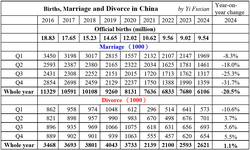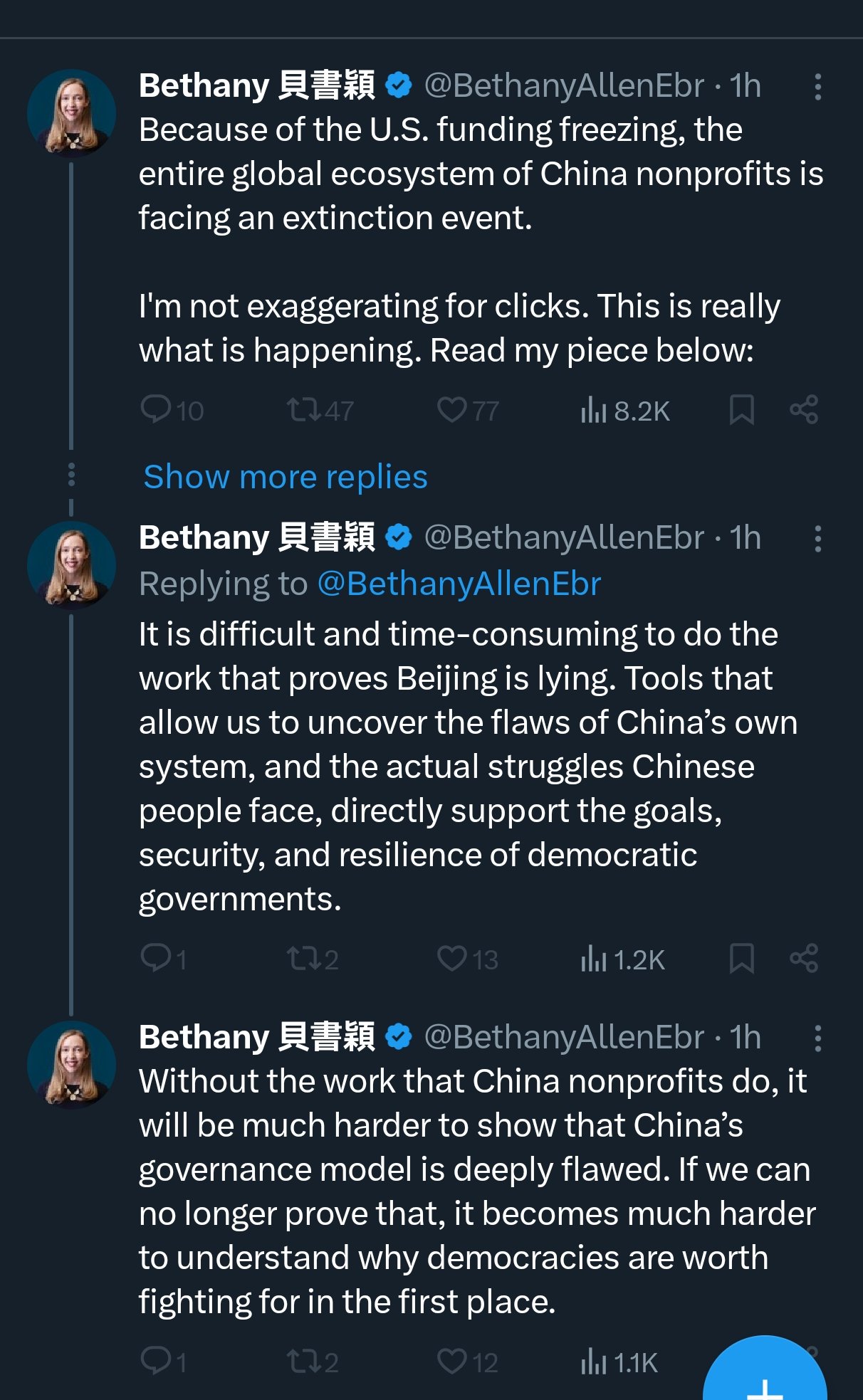Even Thomas Jefferson said that democracy as envisioned for the American Republic is not appropriate for other nations or cultures. We should not be "exporting" it in any fashion.I have to agree with Cooper largely here. The idea that Chinese are the same as Whites is just absurd. They have a different mindset and culture, and the best form of government for them won't be the best form of government for us.
There is no "one size fits all" type of government. Different people take different governance.
You are using an out of date browser. It may not display this or other websites correctly.
You should upgrade or use an alternative browser.
You should upgrade or use an alternative browser.
The China Thread
- Thread starter God's lonely asperger
- Start date
China does have an authoritarian governance model that is based on their 4,000 year-old cultural heritage. Their political system has worked very well for them because their leadership doesn't hate their people and works towards the betterment of their nation and economy, that is the glaring difference between Xi and Schwab and his western minions like Macron, Trudeau or Starmer, who rule their countries for the benefit of the parasitic banksters/oligarch class.
Western-style liberal democracy would not have worked in mainland China, you would have had hundreds of millions of peasants overwhelming their cities, no centralized industrial policy, just financial interests running the country, and their cultural levers would have been taken over by the globalists (see Russia in the 1990s). You would have had a million plus gay parade in Shanghai and Beijing, Taiwan-style degeneracy on steroids:
The Western boogeyman again. A proper turdworldist's last stand par excellence - an emotional appeal performed to create that guttoral and instinctive rejection. Per usual applied when everything logic and analysis related have failed.
You see, China just had to team up with global Jewry, become a Kissinger project, execute the Fourth Industrial Revolution, implement the entire SDG/ESG circus, handover control of its central bank to the BiS and turn its society into an open air prison and technocratic dictatorship (and the blueprint for the rest of the world) because muh LGBT parades in Taiwan.
I also think the handwaving is funny. Calling Macron a Schwab minion (which he is bytheway) whilst purposely ignoring the piles of evidence showing Klaus and the gang literally crawling in front of Dear Leader Xi. And vice versa bytheway. That's audacity personified Coop, I like it. But unfortunately I can't let you get away with it, so here's the infamous 2016 WEF predictive programming '8 Predictions for 2030' video shilling multipolarity. Starting at minute 3:00.


Last edited:
Same here and across the West, one post critical of current year dogma can easily end your career. Try posting against the religion of holocaustianity under your real profile and see where that gets you, lol.
Again, you are too biased on one side.
While China allows discussion of topics that are taboo in the west, they have created a system where all they have to do is disable your smartphone app and you cannot pay for anything anywhere in almost all of China.
You need to have a more balanced neutral outlook, otherwise people here will write you off as just parroting the CCP stance on everything, and no one will take you seriously anymore.
That Schwab guy also said that the Australians were the "perfect example of how people should be" during the shooting grandma with rubber bullets stage so we can get rid of an imaginary virus age. As in; they did nothing really, just comply with whatever tyranny that was thrown at them.
You weren't even allowed to leave the place. Don't forget.
I agree. Fortunately Trump has withdrawn the US from the WHO on Day 1 of his term. Milei, another one of Coop's favs, did the same yesterday.
Now that the trend is set we should soon expect a Chinese withdrawal from the corrupted WHO too. The WHO has proven itself to be an enemy of mankind in the whole Covid1984 saga. This is not too much to ask for a Jew free, independent, affluent, superduper smart and high morality country led by a leader who loves his people. I am talking about China of course.
I expect nothing less.

Javier Milei to follow Donald Trump’s lead and pull Argentina out of WHO
Libertarian leader has embraced upheaval in international institutions triggered by US president
 www.ft.com
www.ft.com
The Western boogeyman again. A proper turdworldist's last stand par excellence - an emotional appeal performed to create that guttoral and instinctive rejection. Per usual applied when everything logic and analysis related have failed.
You see, China just had to team up with global Jewry, become a Kissinger project, execute the Fourth Industrial Revolution, implement the entire SDG/ESG circus, handover control of its central bank to the BiS and turn its society into an open air prison and technocratic dictatorship (and the blueprint for the rest of the world) because muh LGBT parades in Taiwan.
I also think the handwaving is funny. Calling Macron a Schwab minion (which he is bytheway) whilst purposely ignoring the piles of evidence showing Klaus and the gang literally crawling in front of Dear Leader Xi. And vice versa bytheway. That's audacity personified Coop, I like it. But unfortunately I can't let you get away with it, so here's the infamous 2016 WEF predictive programming '8 Predictions for 2030' video shilling multipolarity. Starting at minute 3:00.
Negra: China is a turdworld Klaus Schwab "own nothing and be happy" colony!!!
Reality: home ownership rate in China 95%, with no property tax. Access to housing for young families, higher education, healthcare, private cars, cheap 21st century transport is the best in the industrialized world, bar none. Not exactly a WEF dystopia...
You can paste and rehash as many pictures of Schwab and WEF schwag, it doesn't change the basic fact that China is not running their program, and that Xi doesn't wear tiny hats and lick ZOG boots like your buddy Milei, parasite who shipped his country's gold to ((London)).
Again, you are too biased on one side.
While China allows discussion of topics that are taboo in the west, they have created a system where all they have to do is disable your smartphone app and you cannot pay for anything anywhere in almost all of China.
90% of what you are being fed about China is propaganda, like the notion of a social credit system. This propaganda is aimed mostly at the right wing, and the majority in this segment is highly predisposed to accept this propaganda at face value.
You need to have a more balanced neutral outlook, otherwise people here will write you off as just parroting the CCP stance on everything, and no one will take you seriously anymore.
You can be debanked and unpersonned in the West just as well, and jailed in Iowa of all places for 16 years just for burning the gay flag. The US maintains a secret no-fly list that could be up to a million long. There are thousands of political prisoners in the UK, jailed for online thought crimes.

Iowa man sentenced to 15 years after burning church’s LGBTQ flag
Adolfo Martinez said he tore down the pride flag because he opposes homosexuality. Hate crime and habitual offender charges enhanced his prison sentence.
Last edited:
The Western boogeyman again. A proper turdworldist's last stand par excellence - an emotional appeal performed to create that guttoral and instinctive rejection. Per usual applied when everything logic and analysis related have failed.
You see, China just had to team up with global Jewry, become a Kissinger project, execute the Fourth Industrial Revolution, implement the entire SDG/ESG circus, handover control of its central bank to the BiS and turn its society into an open air prison and technocratic dictatorship (and the blueprint for the rest of the world) because muh LGBT parades in Taiwan.
I also think the handwaving is funny. Calling Macron a Schwab minion (which he is bytheway) whilst purposely ignoring the piles of evidence showing Klaus and the gang literally crawling in front of Dear Leader Xi. And vice versa bytheway. That's audacity personified Coop, I like it. But unfortunately I can't let you get away with it, so here's the infamous 2016 WEF predictive programming '8 Predictions for 2030' video shilling multipolarity. Starting at minute 3:00.
Brother the entire reason China worked with the Talmuds was to hurt the West.
They double-crossed the tribesmen and now Soros has Xi on his hitlist.
This is pretty common knowledge among those who keep up with the news. Why do you pretend not to know it? MusicforthePiano also seems to miss the obvious here as well.
Xi is on Xi's side. China wants to be the next Talmuds. They work with the small-hats in order to learn, copy, and steal from their position as the world's global manipulators.
The Chinese treat their own citizens well, like Talmudic Jews treat each other. They are 100% ethnocentric. We could only wish our government was even half as ethnocentric.
90% of what you are being fed about China is propaganda, like the notion of a social credit system. This propaganda is aimed mostly at the right wing, and the majority in this segment is highly predisposed to accept this propaganda at face value.
You can be debanked and unpersonned in the West just as well, and jailed in Iowa of all places for 16 years just for burning the gay flag. The US maintains a secret no-fly list that could be up to a million long. There are thousands of political prisoners in the UK, jailed for online thought crimes.
Nowhere in my previous posts did I mention a social credit system so stop attributing words to me that I never wrote.
Yes, in the west, you can be debanked, but if you have 500 or 1000 or 5000 dollars in cash (or a friend or relative loans you cash), you can still pay almost anything, anywhere for anything using that. Hotels, food, transport, clothing, etc. In China at this very moment using cash is almost impossible, so if your smartphone app is disabled, you're royally screwed.
I have no love for the globohomo west, and myself have been to China 6 times prior to 2020 and even had long term girlfriends from there in the past, so I know China has many positive things going for it. However it's impossible to take you seriously, because your inability to see both sides of things (or at least take a neutral stance) added together with your constant ass kissing of everything China says and does without question, makes you look like a paid lapdog of the CCP.
Nowhere in my previous posts did I mention a social credit system so stop attributing words to me that I never wrote.
Yes, in the west, you can be debanked, but if you have 500 or 1000 or 5000 dollars in cash (or a friend or relative loans you cash), you can still pay almost anything, anywhere for anything using that. Hotels, food, transport, clothing, etc. In China at this very moment using cash is almost impossible, so if your smartphone app is disabled, you're royally screwed.
I have no love for the globohomo west, and myself have been to China 6 times prior to 2020 and even had long term girlfriends from there in the past, so I know China has many positive things going for it. However it's impossible to take you seriously, because your inability to see both sides of things (or at least take a neutral stance) added together with your constant ass kissing of everything China says and does without question, makes you look like a paid lapdog of the CCP.
Based on the interaction above about tourism in China, you don't seem that neutral either. You were wrong on these issues, stating there were no direct flights from the West to China, and that their international tourism industry has collapsed, which is not true.
There are probably some negative things about China, but almost all of the criticism you read on here and in the media is straight up propaganda.
The propaganda money in the West is 99.9% anti-Chinese, to the tune of $1.6 billion per year from the US govt alone (officially), and that's not even counting the billions in NGOs and other sources.
Yes, in the west, you can be debanked, but if you have 500 or 1000 or 5000 dollars in cash (or a friend or relative loans you cash), you can still pay almost anything, anywhere for anything using that. Hotels, food, transport, clothing, etc. In China at this very moment using cash is almost impossible, so if your smartphone app is disabled, you're royally screwed.
But this problem isn't unique to China. Every country that pushes for cashless society, and I think Sweden is the world leader, can do the same.
But this problem isn't unique to China. Every country that pushes for cashless society, and I think Sweden is the world leader, can do the same.
Yes, but in Sweden you can still use a credit card such as visa, mastercard, amex, etc....while in China 60% to 90% of merchants it's pay with a local Chinese smartphone app or nothing else, not even a western credit card.
However, I do agree with you that any country where cash cannot be used at all for basic essentials (clothing, lodging, food, and transport) is basically a dictatorship where you are coerced to obey. Hence why I do not visit Sweden....it's fast becoming a muslim caliphate anyway.
New marriage statistics in China. Number of marriages declined from ~7.7 million in 2023, to ~6.1 million in 2024. As almost all of the births in China happen within marriage and the number of marriages resulting in births the next year is a stable factor researcher Yi Fuxian predicts the number of births in China to fall below 8 million in 2025 with a predicted TFR of around 0.9.


A Taiwan Independence activist named Johanne Liou, who participated and led the 2014 Sunflower Color Revolution, committed fraud and other crimes in Taiwan, including prostitution.
She was revealed to be involved in a sex trafficking ring and was a high-end escort herself. The bandana she wore during the 2014 color revolution reads "Democracy can't be brought or sold".
She was wanted in Taiwan after failing to appear in court and escaped to the United States on a tourist visa in 2019.
She overstayed her visa and illegally remained in the US. Yesterday, as part of Trump's campaign, she was arrested by ICE and will be deported back to Taiwan. It appears that Taiwan did not send their best to the United States. It only took the USA almost 10 years to find her in Boston.


She was revealed to be involved in a sex trafficking ring and was a high-end escort herself. The bandana she wore during the 2014 color revolution reads "Democracy can't be brought or sold".
She was wanted in Taiwan after failing to appear in court and escaped to the United States on a tourist visa in 2019.
She overstayed her visa and illegally remained in the US. Yesterday, as part of Trump's campaign, she was arrested by ICE and will be deported back to Taiwan. It appears that Taiwan did not send their best to the United States. It only took the USA almost 10 years to find her in Boston.


A Taiwan Independence activist named Johanne Liou, who participated and led the 2014 Sunflower Color Revolution, committed fraud and other crimes in Taiwan, including prostitution.
She was revealed to be involved in a sex trafficking ring and was a high-end escort herself. The bandana she wore during the 2014 color revolution reads "Democracy can't be brought or sold".
She was wanted in Taiwan after failing to appear in court and escaped to the United States on a tourist visa in 2019.
She overstayed her visa and illegally remained in the US. Yesterday, as part of Trump's campaign, she was arrested by ICE and will be deported back to Taiwan. It appears that Taiwan did not send their best to the United States. It only took the USA almost 10 years to find her in Boston.
View attachment 18065View attachment 18066
How much do they pay in prison ms Liou?
A Taiwan Independence activist named Johanne Liou, who participated and led the 2014 Sunflower Color Revolution, committed fraud and other crimes in Taiwan, including prostitution.
She was revealed to be involved in a sex trafficking ring and was a high-end escort herself. The bandana she wore during the 2014 color revolution reads "Democracy can't be brought or sold".
She was wanted in Taiwan after failing to appear in court and escaped to the United States on a tourist visa in 2019.
She overstayed her visa and illegally remained in the US. Yesterday, as part of Trump's campaign, she was arrested by ICE and will be deported back to Taiwan. It appears that Taiwan did not send their best to the United States. It only took the USA almost 10 years to find her in Boston.
View attachment 18065View attachment 18066
She was probably being funded by USAID.
Many such cases.
Interesting as to what this means for the Thucydides Trap.New marriage statistics in China. Number of marriages declined from ~7.7 million in 2023, to ~6.1 million in 2024. As almost all of the births in China happen within marriage and the number of marriages resulting in births the next year is a stable factor researcher Yi Fuxian predicts the number of births in China to fall below 8 million in 2025 with a predicted TFR of around 0.9.
View attachment 17908
It’s already touted as a kind of forced dynamic pushing two great rivals, the incumbent and the upstart, to an even greater war.
A stagnant and free-falling, aging population may give the Trap a steroid injection on the Chinese side, though I tend to see the Chinese (and Russians) as more prudent and risk-averse decision-makers than those in Washington.
The PLA and hawkish civilian elements may decide to escalate suddenly, realizing that the time before the devastating internal demographic crisis in China is too close, the Indians are poorer but demographically “healthier” and with a decent, albeit weaker military, and the US still has military capabilities of note despite the wokeism. The calculation in this case would be that the relative power gap between a much less ally-rich China (BRICS is still too economic and not military-focused) and the US-led bloc will expand because of China’s demographics and the opportunity to reverse this quickly must be taken. India is in BRICS, closer to Russia but militarily mildly to moderately antagonistic towards China at this stage.
Last edited:
Interesting as to what this means for the Thucydides Trap.
It’s already touted as a kind of forced dynamic pushing two great rivals, the incumbent and the upstart, to an even greater war.
A stagnant and free-falling, aging population may give the Trap a steroid injection on the Chinese side, though I tend to see the Chinese (and Russians) as more prudent and risk-averse decision-makers than those in Washington.
The PLA and hawkish civilian elements may decide to escalate suddenly, realizing that the time before the devastating internal demographic crisis in China is too close, the Indians are poorer but demographically “healthier” and with a decent, albeit weaker military, and the US still has military capabilities of note despite the wokeism. The calculation in this case would be that the relative power gap between a much less ally-rich China (BRICS is still too economic and not military-focused) and the US-led bloc will expand because of China’s demographics and the opportunity to reverse this quickly must be taken. India is in BRICS, closer to Russia but militarily mildly to moderately antagonistic towards China at this stage.
China's labor pool has actually been rising sharply in terms of quality. They now have many of the top STEM universities in the world and have been pumping out nearly 5 million STEM grads per year. Most of the Deepseek team are 20-somethings, and many of the top members aren't even graduates of top Chinese universities.
What the China demographic doomers miss is that their numbers are still gigantic in absolute terms, this is a country of 1.4 billion people. And they still have a huge untapped labor pool in the form of ~450 million rural population that they can "activate" by bringing to the cities. They can also raise the retirement age, currently the lowest in the world (60 for men, 50 to 55 for women). They're going to wait until youth unemployment comes down a bit as older Xers and younger boomers retire.
Chinese leaders are very competent and plan way ahead, they have 5,10, 25 year plans that have, to date, all exceeded goals set. Some of the last ones were to catch up in AI and to be leaders in battery and EV industry, which they have set about a decade ago. Most of these leaders have STEM backgrounds and understand how demographics work and can solve differential equations on which population models are based, something that less than 5% of political leaders in the US, Canada or Europe could do.
As I've mentioned before, they want a "soft landing" of around 800-900 million population at the end of the century. And contrary to countries like Japan, S Korea, Germany, US, Canada etc they can provide economic conditions that will raise fertility rates such as low housing, healthcare, transport, daycare costs, China has today the most accessible housing costs for young families of any industrialized country.
But beyond that, what the Chinese have that these other countries don't is cultural levers to make child rearing and family life cool and trendy, which goes 180 degrees against the kind of social engineering young women in the West and Japan/Korea are subjected to. They can also actively steer women towards matrimony by reducing access to young women in the workplace or even paying them to stay at home and raise kids. They would have no qualms discriminating against young women in the workplace if it's deemed to be for the good of the country.
This article agrees with my analysis, which I have gathered by talking with Chinese former college classmates.

China's demographics aren't a short-term problem - Asia Times
In discussions about China’s economy, the issue of demographics comes up quite a lot. In 2022, China’s population began to decrease (and
 asiatimes.com
asiatimes.com
As every labor economist knows, a better-educated workforce is a more productive workforce. The Chinese workers that will retire over the next quarter century — the Gen Xers and older Millennials — are not very highly educated. The workers that will replace them — the Alphas — are very highly educated. That will compensate for much of the loss of the working-age population.
Between welcoming a big youth cohort, raising the retirement age, and sending a lot more kids to college, China should experience few problems from the gentle demographic headwinds of the next two and a half decades.1 Its leaders still need to worry about the long-term demographic challenge after 2050, but most of its rivals are in even worse shape.
All in all, the narrative that demographics will tip the balance of economic and geopolitical power away from China in the next few decades seems overblown and unrealistic. That means more competition for the rest of the world to worry about. But it also means that China’s window of opportunity to act on the world stage won’t close anytime soon.
Last edited:
The demographics of other high IQ nations are all so abysmal nowadays, why would China care? Only America has birthrates a little above extinction numbers - meanwhile Europe, Russia, Japan, South Korea, Australia, all horrible.
She was in America in 10 years and couldn't find a man to marry? Must be a real nice lady.
A Taiwan Independence activist named Johanne Liou, who participated and led the 2014 Sunflower Color Revolution, committed fraud and other crimes in Taiwan, including prostitution.
She was revealed to be involved in a sex trafficking ring and was a high-end escort herself. The bandana she wore during the 2014 color revolution reads "Democracy can't be brought or sold".
She was wanted in Taiwan after failing to appear in court and escaped to the United States on a tourist visa in 2019.
She overstayed her visa and illegally remained in the US. Yesterday, as part of Trump's campaign, she was arrested by ICE and will be deported back to Taiwan. It appears that Taiwan did not send their best to the United States. It only took the USA almost 10 years to find her in Boston.
View attachment 18065View attachment 18066
She was in America in 10 years and couldn't find a man to marry? Must be a real nice lady.



